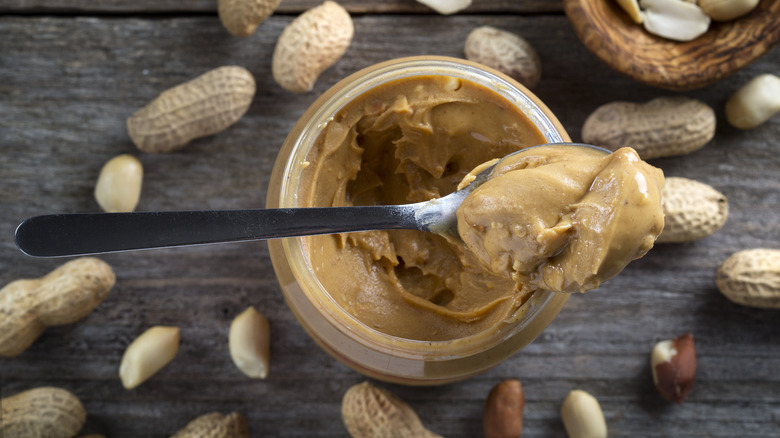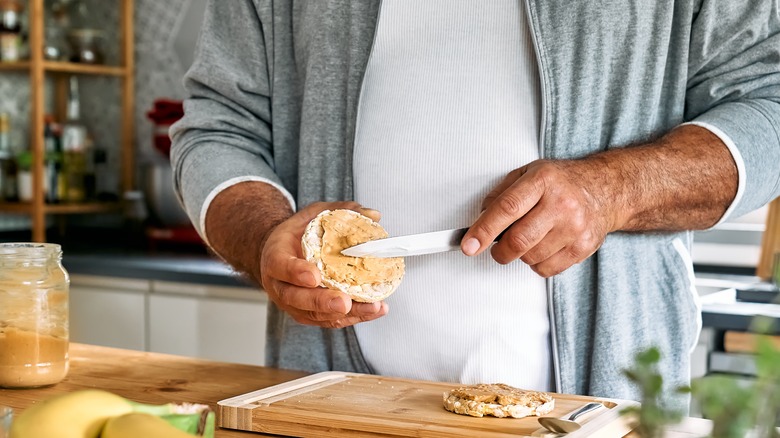What It Means When Eating Peanut Butter Gives You A Headache
Just about anything can give us a headache. Stress, noise, and jaw tension might seem like some of the more obvious ones, but more obscure triggers like slouching, eating processed meat, drinking red wine, and heavy bouts of crying can also set off a headache (via Mayo Clinic). As strange as some of these may sound, a peanut butter-induced headache probably sounds even stranger, yet it is possible.
Peanut butter contains several valuable nutrients. In fact, 1 tablespoon contains 3.6 grams of protein, 90 milligrams (mg) of potassium, over 54 mg of phosphorus, and 27 mg of magnesium, according to the U.S. Department of Agriculture (USDA). However, tyramine and phenylalanine are two compounds found in peanut butter that have been associated with migraine headaches (via Association of Migraine Disorders, Medical Offices of Manhattan).
Migraine triggers look different for everyone. But if your head begins throbbing after a spoonful of nutty peanut butter, it likely means that the creamy spread is one of your own unique triggers. "If every time you eat a handful of nuts, you get a headache in the next four to 12 hours, then it's probably a [migraine] trigger," neurologist Dr. Louise Klebanoff told Health.
Why tyramine and phenylalinine may trigger a migraine
If that handful of nuts you're munching on is peanuts, or if you're smearing a glob of peanut butter onto your toast, you're getting a hefty dose of the amino acid tyramine (via Medical Offices of Manhattan). An enzyme known as monoamine oxidase (MAO) is responsible for processing tyramine in the body, but as researchers discovered in the '50s with patients taking monoamine oxidase inhibitors for mental health disorders, if you're low on MAO, eating tyramine-rich foods may result in migraine (via WebMD). Why tyramine has this effect is not entirely understood, but the compound may potentially play a role in the release of norepinephrine, a neurotransmitter that constricts the blood vessels, which may contribute to migraine pain (via Excedrin).
However, tyramine isn't the only substance found in peanut butter that might be causing your migraines. As previously mentioned, peanut butter also contains phenylalanine (via Association of Migraine Disorders). Early research published in 1996 in Revista de Neurologia addressed this relationship between diet and migraine, with phenylalanine being among the specific substances examined. Because phenylalanine affects vascular tone, it was theorized that it may contribute to migraine attacks in those susceptible to the condition. According to Cardiovascular Physiology Concepts, vascular tone pertains to how much a blood vessel narrows compared to how widely it dilates.
How to avoid these migraine triggers
Because a link between tyramine and migraine headaches has been established, the National Headache Foundation offers guidelines for those who may benefit from what's known as the low tyramine headache diet. The organization divides various tyramine-containing foods into three categories: allowed, use with caution, or avoid. Both peanuts and peanut butter fall into the avoid category. Prohibited foods tend to be aged, fermented, stored for long periods of time, or are not fresh, according to the organization.
According to the Association of Migraine Disorders, phenylalanine is also found in nuts, seeds, some fruits (like avocado, red plums, papayas, and citrus), dried fruits (like raisins, dates, apricots, and canned figs), onions, dairy products, eggs, wheat, freshly baked yeast products, sourdough bread, artificial sweeteners (including those in diet sodas), mustard, ketchup, chili peppers, and mayonnaise.
By eliminating peanut butter from our diet, those prone to migraines will avoid exposure to the sandwich spread's tyramine and phenylalanine content. Migraines can be extremely difficult to cope with, and while peanut butter might make matters worse, the good news is that other dietary changes may also help reduce migraines.



